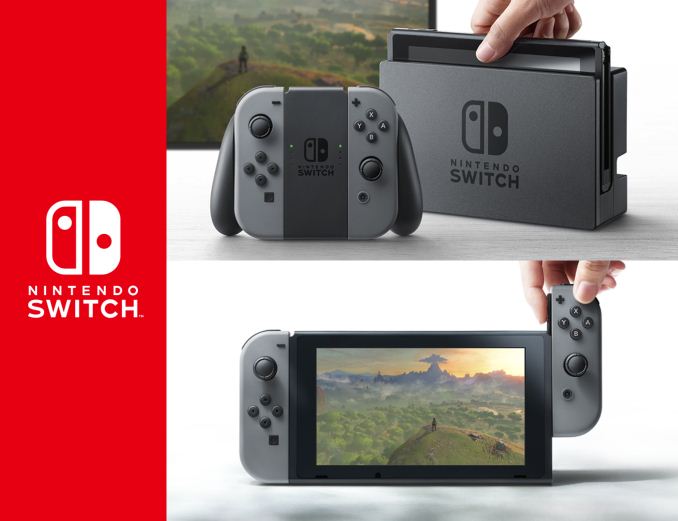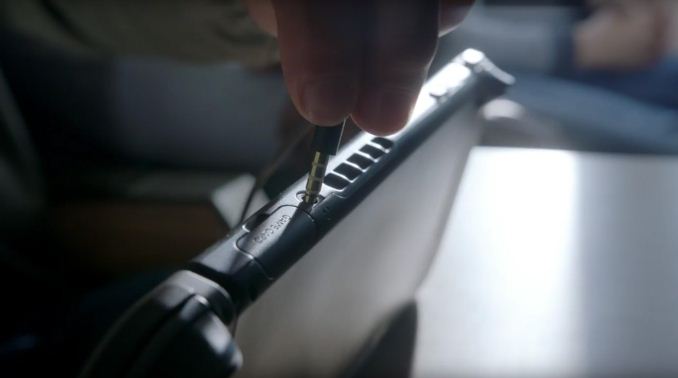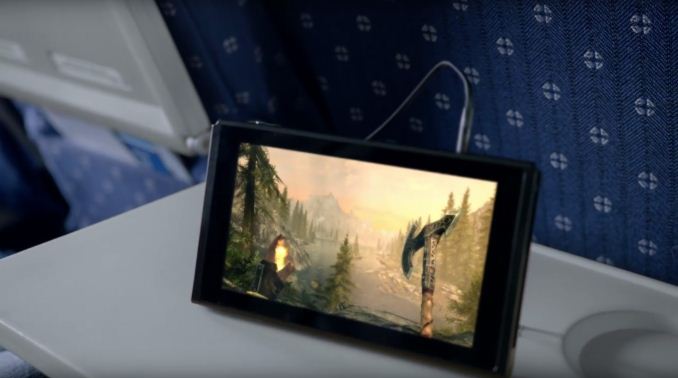Nintendo Announces Switch Portable Gaming Console - Powered by NVIDIA Tegra
by Ryan Smith on October 20, 2016 4:25 PM EST
Earlier today Nintendo took the wraps off of their next generation console, Switch. Formerly known by the codename NX, the Switch is the successor to both Nintendo’s portable DS and set top Wii console lines, utilizing a portable, tablet-like unit that can be docked to behave like a set top console. Today’s announcement, in the form of a 3 minute trailer, is meant to tease the console ahead of its full launch in March of 2017.
While I’ll skip the commentary on the console’s unusual design – dedicated gaming sites can offer better context – I wanted to dive into the hardware in the Switch. Given that this was a teaser, I was not expecting a reveal of any of the hardware specifications of the console, and indeed neither Nintendo’s teaser video nor their related press release made any mention of the underlying hardware. However shortly after the reveal went live, NVIDIA sent out an email to the press and posted a blog of their own. As it turns out, while today is still just a teaser, in some ways we’re already getting more information about the console than in any previous generation of Nintendo’s hardware.
In their blog post, NVIDIA confirmed that they would be providing the underlying SoC for the console. As this is still ultimately a teaser, NVIDIA’s own details are light, but their announcement confirms that it’s a custom version of their Tegra SoC. Curiously, no mention of the CPU core in that SoC is mentioned. However as it’s a Tegra, something ARM-based is the logical (if not only) choice. And on the GPU side, as you’d expect, they’re using a GPU based on one of NVIDIA’s existing GPU architectures, though the company isn’t specifying if it’s Pascal or Maxwell (I’d assume Pascal, but consoles are known for their long development cycles).
Otherwise, as far as specifications go that’s all we get for now. Though as NVIDIA is supplying a whole SoC there are obviously many more parts to the package that we’ll hopefully learn about in the near future. More CPU and GPU details are obviously the most interesting aspect – does the Switch SoC use Denver CPU cores? – but there’s also the matter of memory bandwidth, WiFi support, and the many other functional blocks that make up an SoC.
For NVIDIA, this is the first console hardware win for the company since the PlayStation 3, which launched in 2006. In the set top console market, AMD has since provided the GPU (and often, the CPU) for the most recent generation of consoles. Otherwise NVIDIA has never had a 3rd party portable console win, primarily because both Nintendo and Sony developed their respective SoCs internally for the 3DS and Vita.
In fact, given that Nintendo previously did much of their portable console development work internally, this is a notable shift for how the company operates. The 3DS was essentially a custom SoC combining multiple ARM11 (ARMv6) CPU cores with an OpenGL ES 1.1 generation GPU from the little-known Digital Media Professionals (DMP). So this is the first time Nintendo has contracted out their SoC needs to a third party in such a visible fashion. I’m actually a bit surprised that NVIDIA is even allowed to talk about their involvement at this point in time, given Nintendo’s historical focus on secrecy.
Though all of this also helps to underline just how big a jump in technology the Switch is from the 3DS. On the CPU side alone it’s reasonable to assume we’re looking at CPU design in the neighborhood of 4.x DMIPS/MHz, versus ARM11’s approximate 1.3 DIMPS/MHz rate, so IPC will have increased significantly, never mind an increase in frequency. Meanwhile on the GPU side, Nintendo is going from a GPU that didn’t even have a programmable GPU pipeline (i.e. shaders) to a fully modern GPU, essentially catching up on a decade of mobile GPU development in a single bound. Given that the console has to work as both the company’s portable and set top consoles, Nintendo has opted to use far more modern tech than their traditionally conservative designs.
Finally, without reading too much into a 5 paragraph announcement, there is one other interesting nugget of information in NVIDIA’s blog post that further shows just how deep the NVIDIA/Nintendo relationship is going here. Along with providing the SoC, NVIDIA also has a major stake in the development of the console’s API and middleware. While NVIDIA presumably isn’t developing the entire software stack, they make special note of the fact that they are providing a new “lightweight” API, NVN, for the console. NVIDIA is also providing middleware in the form of “a revamped physics engine, new libraries, advanced game tools and libraries” and “custom software for audio effects and rendering” which sounds a great deal like NVIDIA having brought over major parts of their GameWorks SDK, including the PhysX physics simulation libraries and VRWorks Audio library.
In any case, it will be interesting to see how this plays out over the next few months. The mobile world has changed significantly since the 3DS was launched in 2011, something that the Switch’s design makes obvious. Nintendo has gone in a very different direction than either their console rivals or the smartphone market that is always threatening to encroach on mobile consoles, and that’s reflected in both the unusual dual-mode console and the hardware inside of it.












109 Comments
View All Comments
Wolfpup - Friday, October 21, 2016 - link
Com, this is going to be in line with an Xbox 360/Wii U/PS3, certainly not an Xbox One let alone Scorpio. It'll quite likely actually best the last gen systems (maybe even by a nice margin) but it's not competing with an Xbox One.And the DS/3DS had lots of good games-my main complaints were the focus on gimmicks (touch and "3D"), but still a new Nintendo portable with a bunch more power is always a nice thing.
I haven't played a Pokemon game since the originals, but from everything I've read, they've made tons of changes and improvements to them. If I didn't have such a huge backlog I'd have tried any of the last few for sure.
Communism - Friday, October 21, 2016 - link
Don't comment on things you don't understand.Read my comments further down for my analysis of the console.
fanofanand - Tuesday, October 25, 2016 - link
Wolfpup is spot on, there is a 0% chance of your statement being accurate. There is not a single chance in all of heaven or hell that this mobile SOC exceeds 2 Tflops. None. Nada. Zilch.Morawka - Thursday, October 20, 2016 - link
your kidding right? It is still a console with under-powered hardware compared to xbox one and PS4, and developers will have to heavily modify their Xbone and PS4 builds so it to run on a device that runs off batteries.Nintendo should have made the best console they could make, and the best Nintendo DS they can make with budget in mind. instead they are trying to make a hybrid that makes compromises for the form factor.
In the trailer you can even see it dip below 30FPS on zelda and mario.
Morawka - Thursday, October 20, 2016 - link
Also is this the end of Shield Portable? will nvidia risk stepping on Nintendo's toes with a similar design?Communism - Thursday, October 20, 2016 - link
Why would you buy a nintendo handheld to play anything other than a mainline Pokemon?Why would you buy an xbox to play anything other than halo?
Why would you buy a playstation at all?
hahmed330 - Thursday, October 20, 2016 - link
Nope not even close!!Firstly GTX 750ti had 1.3 Teraflop and it cleaned PS4's clock even though if it was at 1.84 Tflops.
Secondly nvidia's most efficient GPU right now is 16nm Finfet Nvidia P4 which gives out 5.5 Teraflops for 50 watts (this includes power consumed by PCIE bus and GDDR5 192GB/s) that comes out at 1.65 Tflops for 15 watts (dock mode) faster the GTX 750ti.
Morawka - Thursday, October 20, 2016 - link
the memory bus is the problem on these small chips, not the Theoretical max compute. the NX will be well below 175 Gbps which is what the PS4 can stream in textures/data.This means new Call of duty's, new battlefields, new assassin creeds, will all have to be downgraded so it can run off of a battery. Or most likely, they won't be released at all on Nintendo's new console, which is what happened with the Wii U.
Communism - Friday, October 21, 2016 - link
Pascal has over 2.5x the memory bandwidth efficiency of the PS4 , probably closer to 3x.This is why the Geforce GTX 1060 is triple as fast as the 7870, despite having similar memory bandwidth.
But why waste my time arguing with AMD Red Team Plus.
psychobriggsy - Friday, October 21, 2016 - link
Pascal's memory compression is likely to be around 50%, maybe 60% more efficient than the zero memory compression on the PS4 GPU. PS4Pro has 40-50% efficient memory compression, btw.However Switch, at best, is going to use LPDDR4 128-bit, which is around 50GB/s (say 80GB/s effective).
But ... with tiled rendering (http://www.realworldtech.com/tile-based-rasterizat... on-die using a large SRAM (look how small the 4MB L3 is on the A10 Fusion) a lot of the bandwidth issues go away. However, that's if that is how this custom Tegra is architected.